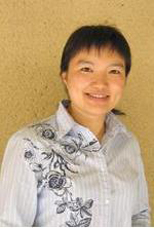发表论文(*为通讯作者):
Wu Z, Pang L, Ding M*. (2025). CFI-1 functions unilaterally to restrict gap junction formation in C. elegans. Development. 152(1): dev202955. doi: 10.1242/dev.202955.
Miao Y#, Du Y#, Wang B, Liang J, Liang Y, Dang S, Liu J, Li D, He K*, Ding M*. (2024). Spatiotemporal recruitment of the ubiquitin-specific protease USP8 directs endosome maturation. elife. 13:RP96353. doi: 10.7554/elife.96353.
Guan L#,
Yang Y#,
Jing Liang L#,
Miao Y,
Shang A,
Wang B,
Wang Y,
Ding M*. (2022). ERGIC2 and ERGIC3 regulate the ER-to-Golgi transport of gap junction proteins in metazoans.
Traffic. 23(3):140-157. doi: 10.1111/tra.12830.
Cong D#,
Ren J#,
Zhou Y,
Wang S,
Liang J,
Ding M*
,
Feng W*. (2021) Motor domain-mediated autoinhibition dictates axonal transport by the kinesin UNC-104/KIF1A.
PLoS Genetics doi: 10.1371/journal.pgen.1009940.
Yang L, Liang J, Lam S-M, Yavuz A, Shui G, Ding M and Huang X*. (2020) Neuronal lipolysis participates in PUFA-mediated neural function and neurodegeneration. EMBO Reports 21:e50214 PMID: 33034119.
Guan L#, Zhan Z#, Yang Y, Miao Y, Huang X, and Ding M*. (2020) Alleviating chronic ER stress by p38-Ire1-Xbp1 pathway and insulin-associated autophagy in C. elegans neurons. PLoS Genetics 16(9):e1008704.
Yang X, Liang J, Ding L, Li X, Lam S-M, Shui G, Ding M and Huang X*. (2019) Phosphatidylserine synthase regulates cellular homeostasis through distinct metabolic mechanisms. PLoS Genetics 15:e1008548 PMID: 31869331
Wang J and Ding M*. (2018) Robo and Ror function in a common receptor complex to regulate Wnt-mediated neurite outgrowth in C. elegans. PNAS doi:10.1073/pnas.1717468115.
Yao Y, Li X, Wang W, Liu Z, Chen J, Ding M and Huang X*. (2018) MRT, functioning with NURF complex, regulates lipid droplet size. Cell Reports 24:2972-2984 PMID: 30208321
Ding L, Yang X, Tian H, Liang J, Zhang F, Wang G, Wang Y, Ding M, Shui G and Huang X*. (2018) Seipin regulates lipid homeostasis by ensuring calcium-dependent mitochondrial metabolism. EMBO J. 37:e97572 PMID: 30049710
Guan L#, Ma X#, Zhang J, Liu J, Wang Y, and Ding M*. (2016) The Calponin Family Member CHDP-1 Interacts with Rac/CED-10 to Promote Cell Protrusions. PLoS Genetics Jul 14;12(7):e1006163.
Cheng Y#, Wang J#, Wang Y, and Ding M*. (2015) Synaptotagmin 1 directs repetitive release by coupling vesicle exocytosis to the Rab3 cycle. eLife 4:e05118.
Wu J, Cheng Y, Wang J, Chen L, Ding M, and Wu J*.(2015) Structural insight into the mechanism of synergic autoinhibition of SAD kinases. Nature Communications DOI:10.1038/ncomms9953.
Wang J, Chitturi J, Ge Q, Laskova V, Wang W, Li X, Ding M, Zhen M* and Huang X*. (2015) The C. elegans COE transcription factor UNC-3 activates lineage-specific apoptosis and affects neurite growth in the RID lineage. Development 142:1447-1457.
Qin J, Liang J, and Ding M*. (2014) Perlecan antagonizes collagen IV and ADAMTS9/GON-1 in restricting the growth of presynaptic boutons. Journal of Neuroscience 34(31):10311-10324.
Zhang J, Li X, Jevince AR, Guan L, Wang J, Hall DH, Huang X*, and Ding M*. (2013) Neuronal target identification requires AHA-1-mediated fine-tuning of Wnt signaling in C. elegans. PLoS Genetics 9(6): e1001056.
Song S#, Zhang B#, Sun H, Li X, Xiang Y, Liu Z, Huang X*, and Ding M*. (2010) A Wnt-Frz/Ror-Dsh pathway regulates neurite outgrowth in Caenorhabditis elegans. PLoS Genetics 6(8): e1003618.
Ding M* and Shen K. (2008) The role of the ubiquitin proteasome system in synapse remodeling and neurodegenerative diseases. Bioessay 30: 1075-1083.
Ding M, King RS, Berry EC, Wang Y, Hardin J, and Chisholm AD. (2008) The cell signaling adaptor protein EPS-8 is essential for C. elegans epidermal elongation and interacts with the ankyrin repeat protein VAB-19. PloS One 3: e3346.
Ding M, Chao D, Wang G, Shen K. (2007) Spatial regulation of an E3 ubiquitin ligase directs selective synapse elimination. Science 317, 947-951.
Ding M, Woo WM, Chisholm AD. (2004) The cytoskeleton and epidermal morphogenesis in C. elegans. Exp Cell Res 301:84-90.
Ding M, Goncharov A, Jin Y, Chisholm AD. (2003) C. elegans ankyrin repeat protein VAB-19 is a component of epidermal attachment structures and is essential for epidermal morphogenesis. Development 130:5791-5801.
